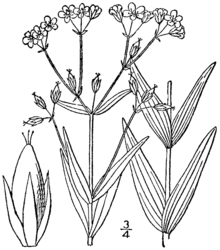
Hypericum socotranum is a species of flowering plant in the Hypericaceae family which is endemic to the island of Socotra in Yemen. Its natural habitats are subtropical or tropical dry forests and rocky areas.
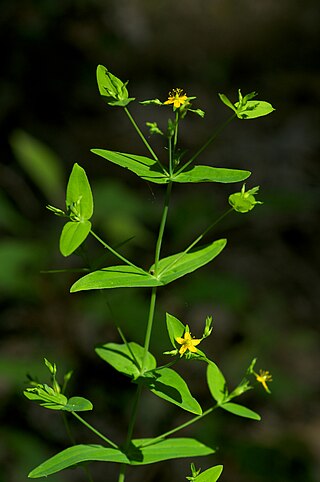
Hypericum mutilum is a species of St. John's wort known by the common name dwarf St. John's wort. It is native to parts of North America and is present in other parts as an introduced species. It is an annual or perennial herb taking a multibranched erect form up to about 60 centimeters tall. The oval green leaves are one or two centimeters long and are covered in tiny glands. The inflorescence is a compound cyme of tiny flowers. H. mutilum subsp. mutilum and subsp. boreale have a diploid number of 16, and H. mutilum subsp. boreale can have a diploid number of 18.
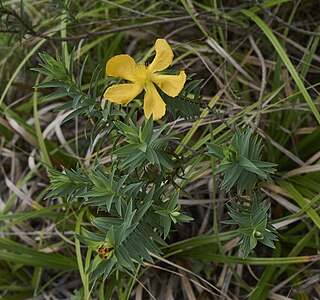
Hypericum terrae-firmae is a woody perennial flowering plant in the St. John's wort family Hypericaceae. It is an endemic plant species of Belize.

Hypericum aegypticum is a species of flowering plant of the St. John's wort family (Hypericaceae) which is native to the Eastern Mediterranean. It was described by Carl Linnaeus in the second volume of his Species Plantarum in 1753, who named it after Egypt despite it not being distributed there. The plant is commonly known as shrubby St. John's wort or Egyptian St. John's wort in English. Like other members of section Adenotrias, it is found among limestone rocks in coastal areas. While it has been evaluated as threatened on the island of Malta, the species has no legal protections.
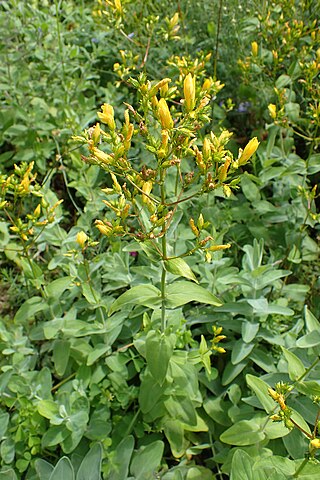
Hypericum annulatum is a species of flowering plant in the family Hypericaceae. It is a perennial herb of varying heights which grows upright, with more than a hundred flowers of a golden yellow color. First described in 1827, the species has a wide distribution from Eastern Europe to East Africa, and its appearance can vary greatly based on its geographic location. It has been used in Bulgarian folk medicine, and has more recently been investigated for its effectiveness in slowing the growth of or killing certain types of human cancer.

Hypericum boreale, also known as northern St. John's-wort, is a short-lived perennial species of flowering plant in the family Hypericaceae, section Trigynobrathys.

Hypericum hookerianum, or Hooker's St. John's Wort, is a perennial shrub in the flowering plant family Hypericaceae native to eastern and southern Asia. The specific name hookerianum is named for William Jackson Hooker.

Hypericum punctatum, the spotted St. John's wort, is a perennial herb native to North America. The yellow-flowered herb occurs throughout eastern North America into southern Canada. The process of microsporogenesis carried out by this plant is prone to errors in chromosomal segregation. It has a diploid number of 14 or 16. Insects are attracted to the plant's pollen and the hypericin in the plant's leaves is toxic to mammals.
Hypericum cuisinii is a perennial herb in the genus Hypericum, in the section Adenosepalum. The herb has pale yellow flowers and occurs in Greece and Turkey.
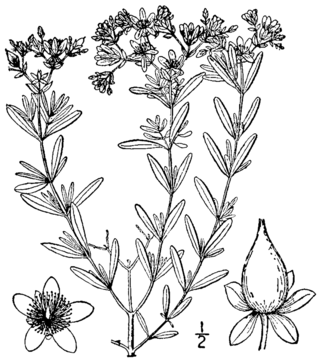
Hypericum densiflorum, also known as bushy St. John's wort or dense St. John's wort, is a perennial herb in the flowering plant family Hypericaceae native to North America. The specific epithet densiflorum is Latin, meaning "densely flowered", referring to the many-flowered cymes.

Hypericum canadense, known as Canadian St. Johns-wort, lesser St. John's wort, and lesser Canadian St. Johnswort, is a flowering plant in the genus Hypericum. It is a yellow-flowering annual or perennial herb native to North America and introduced to Ireland and The Netherlands. The specific epithet canadense means "Canadian".

Hypericum undulatum, the wavy St Johns Wort, is a herbaceous perennial flowering plant native to western Europe and northern Africa. The specific name undulatum is Latin, meaning "wavy" or "undulated", referring, just as the common name, to the wavy leaf margins of the herb. The plant has a diploid number of 16 or 32.

Hypericum denticulatum, the coppery St. John's Wort, is a perennial herb in the flowering plant family Hypericaceae. It is native to the Eastern United States. The species has two varieties, H. denticulatum var. recognitum and H. denticulatum var. acutifolium. The herb has a diploid number of 24 or 48.

Hypericum humboldtianum is a species of shrubby flowering plant in the St. John's wort family Hypericaceae native to Colombia and Venezuela.

Hypericum aucheri, also known as Koramanotu in Turkish, is a herbaceous perennial flowering plant in the St. John's wort family Hypericaceae.

Hypericum coris, the heath-leaved St. John's wort, also called yellow coris, is a species of flowering plant in the family Hypericaceae, and is the type species of sect. Coridium. It is a low shrub, and it is found in Switzerland and northwestern Italy. The species has been a popular garden plant since the 18th century, valued for its long flowering period and for how well it adapts to cultivation.
Hypericum harperi, the sharplobe St. Johnswort or Harper's St. John's wort, is a perennial flowering plant in the family Hypericaceae. It is an aquatic herb native to southeast North America. H. harperi has a diploid chromosome number of 24.
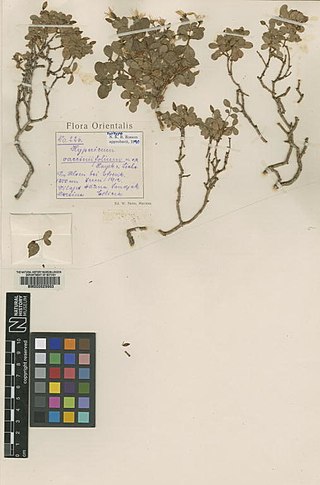
Hypericum vacciniifolium is a species of flowering plant in the flowering plant family Hypericaceae. It was first described by August von Hayek and Walter Siehe in the Ann. K. K. Naturhist. Hofmus. journal in 1914 from a specimen collected by Siehe in 1912.

Hypericum heterophyllum is a flowering plant in the Hypericaceae family and is the only species in Hypericum sect. Heterophylla.
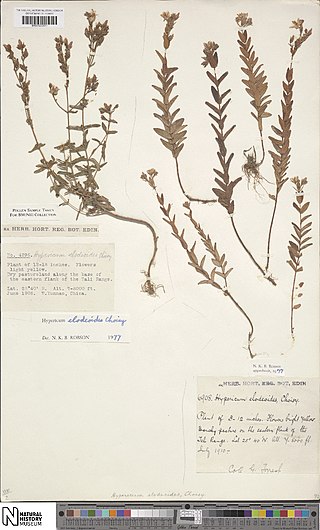
Hypericum elodeoides, commonly called the Himalayan St. John's Wort, is a species of flowering plant of the St. John's wort family (Hypericaceae).


